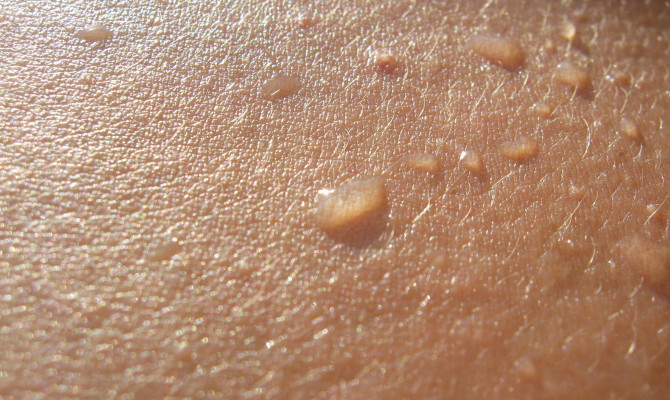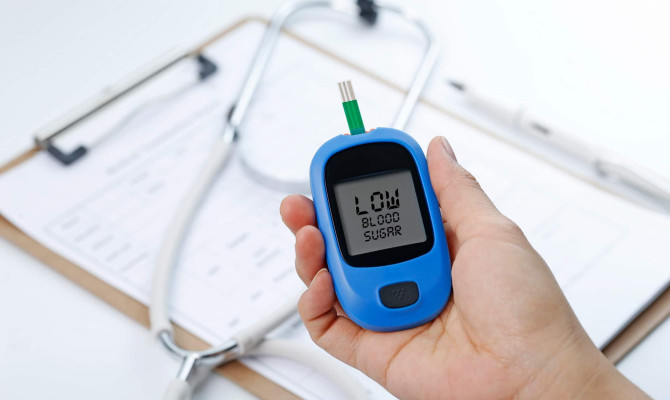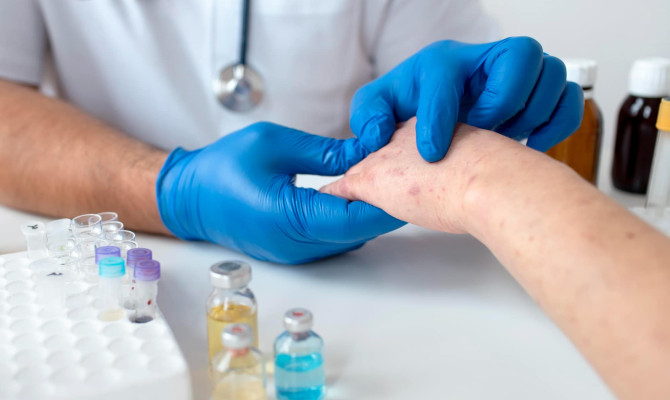Fever : Types, Symptoms, Reasons, Complications, and Management

- Fever
- 16 Aug 2023
Overview
What is fever ?
Fever, pyrexia, or hyperthermia refers to an elevated body temperature. It indicates the body’s natural defense against infection, and it disappears in a couple of days. However, a high temperature may indicate a dangerous infection that demands prompt medical attention. The average human body temperature is 37°C, or 98.6°F. 1Overview | Researched based study from Medlineplus.gov A few degrees over average body temperature indicates fever.
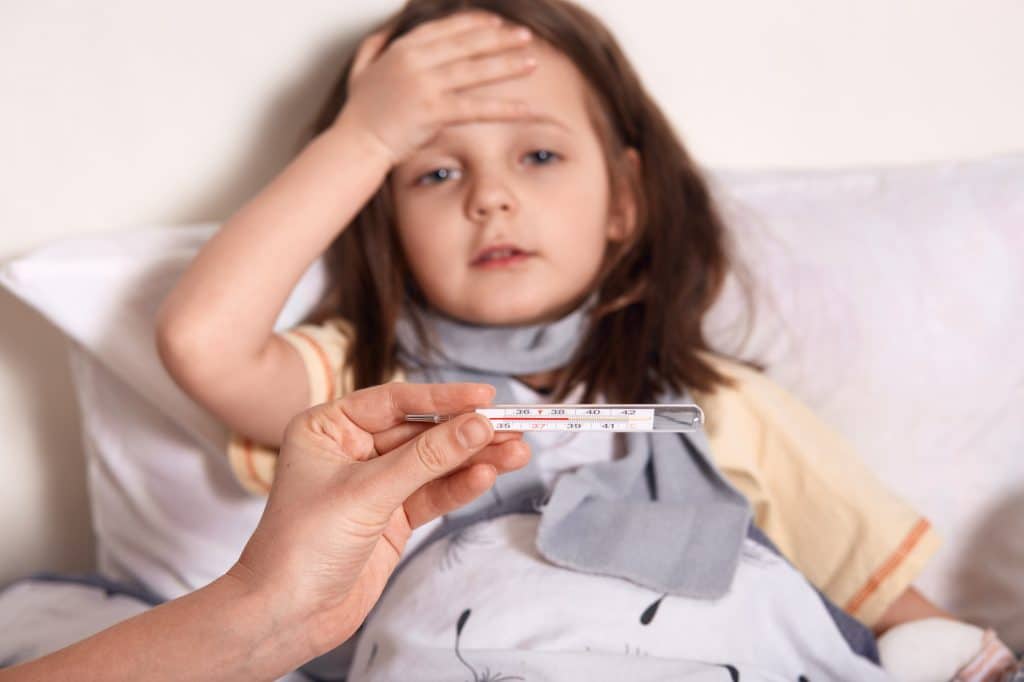
Types
Types of fever
Depending on a number of variables, there are various forms of fever
Depending on the severity
- Low grade – 38.1 to 39 °C or 100.5 to 102.2°F
- Moderate – 39.1 to 40°C or 102.2 to 104.0°F
- High grade – 40.1 to 41.1°C or 104.1 to 106.0°F
- Hyperpyrexia – above 41.1 °C or 106.0°F 2Types | Researched based study from Sciencedirect.com
Depending on the duration
- Acute – fewer than seven days. Upper respiratory virus infection
- Sub-acute – can last a maximum of fourteen days. Flu typhoid
- Chronic or persistent – more than 14 days long. HIV and tuberculosis
Based on the occurrence pattern
- Continuous or sustained – does not change over 1.5°F (1°C) in twenty-four hours, yet is seldom normal at this period. (For instance, typhoid sickness.)
- Intermittent type – the fever happens occasionally, but only for a few hours during the day. (Tuberculosis and malaria are two examples.)
- Remittent – varies by over 2 °C but fails to return to normal. (Infectious endocarditis is an example.)
Reasons
Identify the reasons of fever
A fever is only a symptom of several infections and diseases, including the following:
Infections
- Viral infections – influenza (flu), common cold (rhinovirus), COVID-19, Swine flu (H1N1), dengue, malaria, HIV, Hepatitis, etc.
- Bacterial infections – enteric fever, tuberculosis, brucellosis, bacterial gastroenteritis, Urinary tract infections (UTI),3Reasons | Researched based study from Medlinelus.gov strep throat, etc.
- Fungal infections – valley fever 4Reasons | Researched based study from Cdc.gov Mucor mycosis, etc.
Autoimmune or inflammatory disorders
- Rheumatoid arthritis.
- Systemic lupus erythematosus.
- Crohn’s disease.
- Ulcerative colitis.
- Vasculitis or periarteritis nodosa.
- Thrombophlebitis.
- Fever is often the first sign of cancer, especially in leukemia, non-Hodgkin lymphoma, and Hodgkin disease.
Other conditions
- Sunburn – excessive exposure to direct sunlight.
- Heat stroke – by extreme heat or extended, intense exercise.
- Dehydration may cause fever.
- Vaccinations – such as diphtheria, tetanus, pneumococcal, or COVID vaccine, may cause a low-grade fever for 1-2 days.
- A few medications – antibiotics, antihistamines, and seizure medications.
- Silicosis – a lung condition by prolonged exposure to particles of silica.
- Alcohol withdrawal 5Reasons | Researched based study from Nlm.nih.gov
- Amphetamine abuse.
Symptoms
What are the symptoms of fever ?
According to the underlying cause, any of the following fever signs and symptoms may manifest:
- Increased temperature. (Over 104.40°C)
- Appetite loss.
- Feeling weak.
- Sweating.
- Fatigue.
- Headache.
- Irritability.
- Muscle pain.
- A flushed face
- Dry and hot skin.
- Shivers and chills.
- Less urine output.
- Dark urine.
- Diarrhea.
- Vomiting.
Prevention
Steps to prevent fever
Here are some suggestions for lowering exposure to infectious diseases and preventing fevers:
- Often wash both hands using water and soap. 6Prevention | Researched based study from Mayoclinic.org If no washing sinks are available, use hand sanitizing gels or sprays.
- Refrain from touching the mouth, nose, or eyes with unclean hands, as these are the main ways that viruses and bacteria can enter the body and cause infections.
- Keep your distance from people who are contagious by not shaking hands, kissing, or exchanging drinks or utensils.
- Clean surfaces that people, such as doorknobs, regularly touch.
- Use tissues to contain coughs and sneezes, then properly dispose of them.
- Improve immunity by getting adequate sleep, eating well, and working out frequently.
- Remain at home while unwell to avoid spreading it.
- Obtain the appropriate vaccinations for infectious diseases like COVID-19 and the flu.
- Adhere to accepted public standards for mask use and social distance.
Consequences
What are the consequences ?
Consequences of a fever may include the following:
- Skin rashes.
- Bruises.
- Stiff neck.
- Dehydration.
- Seizures.
- Breathing difficulty.
- Loss of consciousness.
- Confusion.
- Liver failure.
- Kidney problem.
- Shock.
- Coma.
- Multi-organ failure.
- Sepsis.
- Death in more extended periods of fever.7Complications | Researched based study from Nlm.nih.gov
Diagnosis
Diagnosis of fever
A doctor may ask first about the patient’s symptoms, personal history, medical history, family history, and travel history, then may perform a physical examination and some tests, such as those listed below, to determine the cause of the fever and formulate a treatment plan.
Physical examination
- Check the body temperature – oral temperature and temperature in the rectum, ear, or armpit may be checked with a thermometer.
- Check for lymph gland swellings.
A swab test
- Swab the throat or nasal passages to check for respiratory infections.
Blood test
- White blood cell count.
- Erythrocyte sedimentation rate.
- CRP (C-reactive protein) level to look for inflammation.
- Blood culture test to look for any infections.
- Other specific tests, such as ELISA for HIV, tuberculin tests for tuberculosis, etc., if suspected.8Diagnosis| Researched based study from Nlm.nih.gov
Urinary analysis
- Urine test to look for urinary tract infections.
- Kidney function.
Imaging tests
- If needed, a chest x-ray or other imaging tests.
Management
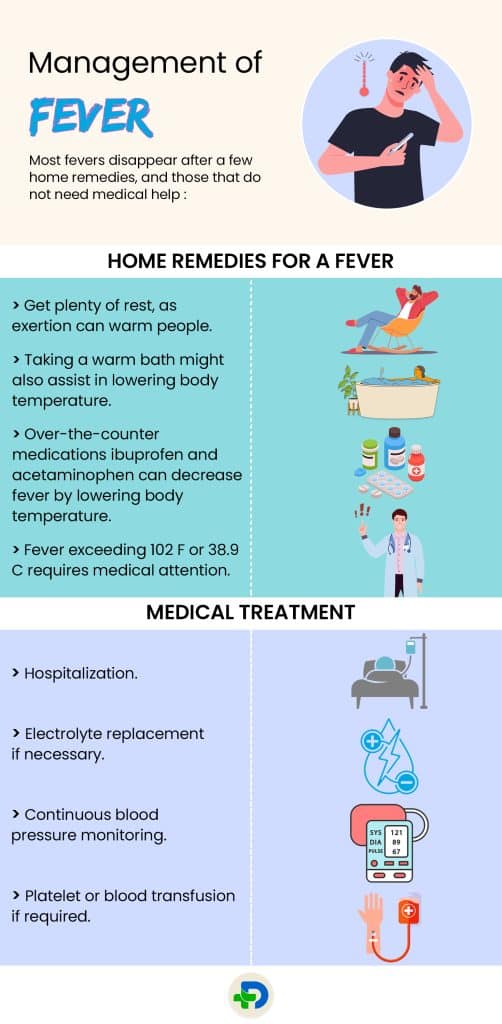
Management of fever
Most fevers disappear after a few home remedies, and those that do not need medical help:
Home remedies for a fever
Things to do to make oneself or their child comfortable during a fever:
- Getting enough liquids will help you sweat less and reduce the heat your skin retains. Healthy options include clear broth and water. Mothers should only give breast milk or formula to infants under 6 months old.
- Get plenty of rest, as exertion can warm people.
- Taking a warm bath might also assist in lowering body temperature.
- Keep the room cold, dress in light clothing, and use only a sheet or thin blanket as bedding.
- Over-the-counter medications ibuprofen and acetaminophen can decrease fever by lowering body temperature.9Management| Researched based study from journalslibrary.nihr.ac.uk
- Do not give aspirin to anyone under 17, as it can result in the fatal disease of Reye’s syndrome.
- Adults with low-grade fevers should avoid taking fever-reducing drugs since they might help fight the infection-causing bacteria.
- Fever exceeding 102 F or 38.9 C requires medical attention.
Medical treatment
People with high fever or fever that does not seem to improve with medication may need medical management and may include:
- Hospitalization.
- Supportive care with Intravenous fluid. (IV)
- Electrolyte replacement if necessary.
- Constant tracking of vital signs.
- Continuous blood pressure monitoring.
- Management of blood sugar levels.
- Platelet or blood transfusion if required.
For infants
- It may be necessary to admit infants to the hospitals for testing and treatment, especially those under two months old.
- Fever in young infants may indicate a severe infection requiring intravenous (IV) treatment and 24-hour supervision.
Prognosis
Prognosis of fever
Although a fever is typically nothing to worry about, the underlying condition may require medical attention. The fever’s cause, accompanying symptoms, pattern, and intensity affects how it will likely progress. Usually, a fever subsides without the need for medical intervention. However, suppose a kid or an older adult experience a fever. In that case, if they have other severe symptoms that are worsening or if they have a compromised immune system, they should seek emergency medical attention.
Any feedback on this article?
 This Articles content was accurate
This Articles content was accurate Very Informative Article
Very Informative Article I have a question or a comment
I have a question or a comment
 This article contains inaccurate content
This article contains inaccurate content This article was not helpful
This article was not helpful I have a question or a comment
I have a question or a comment
We appreciate your helpful feedback!
Checkout our social pages
References
-
Medline Plus
Body temperature norms | Overview
-
Science Direct
Fever, fever patterns and diseases called ‘fever’ – A review | Types
-
Medline Plus
Fever | Reasons
-
Centers for Disease Control and Prevention
Symptoms of Valley Fever (Coccidioidomycosis) | Reasons
-
National Library of Medicine
Introduction to Alcohol Withdrawal | Reasons
-
Mayo Clinic
Fever | Prevention
-
National Library of Medicine
The pathophysiological basis and consequences of fever | Complications
-
National Library of Medicine
Physiology, Fever | Diagnosis
-
Journals Library
Paracetamol and Ibuprofen for the treatment of fever in children: the PITCH randomised controlled trial | Management














